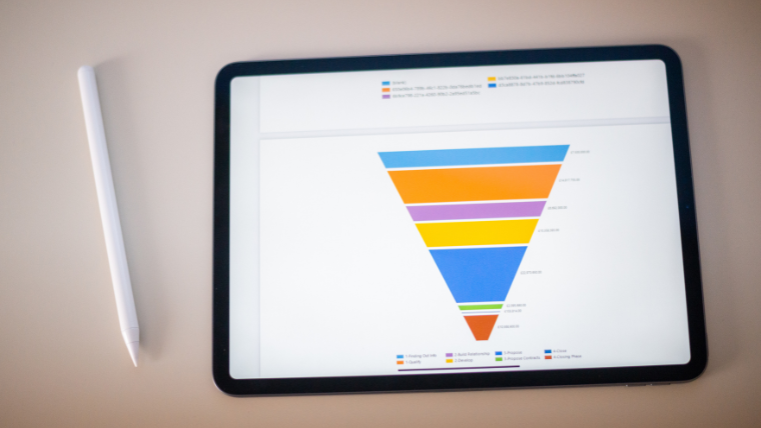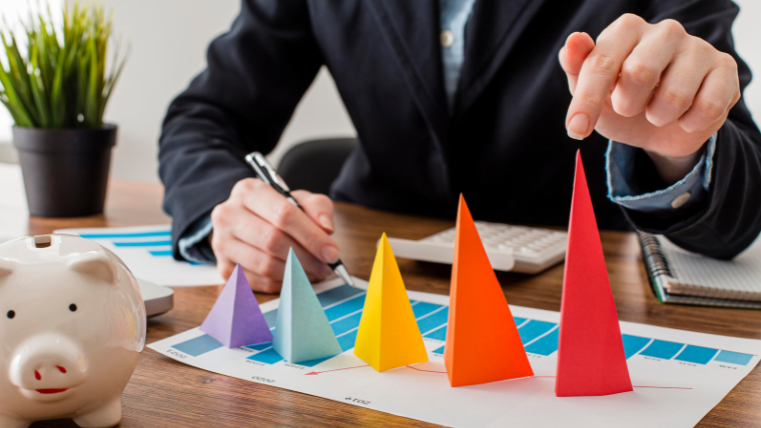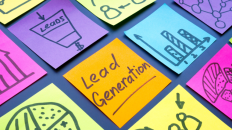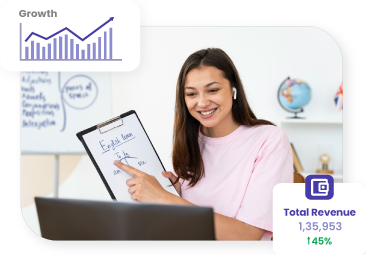Have you ever wondered why some people engage with your content but never take the next step, whether that’s signing up for a course, joining your community, or booking a session? It’s not that they’re uninterested; they might just be overwhelmed by unclear messaging, too many options, or a lack of guidance on what to do next.
This is where a business funnel becomes invaluable. It sets up a structured system to organize and track how your audience interacts with your offerings. For content creators, fitness coaches, and course developers, a well-designed funnel is more than a marketing tool. It’s a way to connect meaningfully and guide your audience toward becoming loyal customers.
In this blog, we’ll break down what a business funnel is, the stages involved, and how to make it work for your business.
What is a Business Funnel?
A business funnel guides potential customers from their first interaction with your brand to take meaningful action, whether purchasing, attending a webinar, or joining your community.
Think of it as a structured path: at the top, you attract a broad audience, and as they move down the funnel, only the most engaged and interested individuals become your customers.
To make business funnels genuinely effective, it’s essential to break them down into actionable stages that guide your audience step by step.
What are the Stages of a Business Funnel?
Understanding the stages of a business funnel is about meeting your audience where they are and guiding them with purpose. It’s how you turn interest into action and action into loyalty.
Let’s break down each stage of the business funnel and explore how thoughtful, customized approaches can leave a lasting impact and turn curiosity into commitment.
- Awareness: Catching Attention in a Crowded Market
At the top of the business funnel, your goal is simple: get noticed. This stage is about creating visibility and helping potential customers discover your brand. The challenge for content creators and community builders is to stand out amidst the endless scroll. But how do you do that?
To Succeed in the Awareness Stage:
- Create Value-Driven Content: Value-driven content focuses on addressing the specific challenges, interests, or aspirations of your audience while providing actionable takeaways or meaningful insights. It’s content designed not just to engage but to educate, inspire, or solve a problem. For instance, a fitness coach might share a quick workout tip, or a course creator could offer a sneak peek of their material.
- Leverage Paid Advertising: Use targeted ads on platforms like Facebook, Google, or Instagram to reach specific demographics. For example, if you’re an astrologer, create ads around zodiac-based workshops.
- Network and Collaborate: Partner with influencers or join niche online communities to expand your reach. A professor offering online lectures might collaborate with educational influencers for a wider audience.
- Interest: Building Relationships Beyond First Impressions
Once you’ve captured attention, the next step is to nurture it, a critical process that, when done effectively, can generate 50% more sales-ready leads at 33% lower costs. At this stage of the sales funnel, your focus should be on giving your audience compelling reasons to stay engaged and building trust that leads to action.
Strategies for the Interest Stage:
- Lead Magnets: Offer free resources that address specific pain points, like an e-book on ‘time management’ for entrepreneurs or a free fitness challenge for beginners.
- Email Campaigns: Create an email series that provides value while informing your audience about your offerings. A course creator might share weekly insights or exclusive tips related to their niche.
- Interactive Content: Use polls, quizzes, or surveys to engage your audience on platforms like Instagram or X, which are ideal for interactive activities due to their built-in tools and high user engagement. For example, a content creator could host a “What’s Your Content Style?” quiz to entertain followers while gathering insights about their preferences.
- Evaluation: Helping Prospects Weigh Their Options
This stage is where potential customers evaluate your offerings against competitors. It’s your chance to show why your digital marketing sales funnel is worth their time and investment.
How to Win in the Consideration Stage:
- Social Proof: Share testimonials, reviews, or user-generated content. For instance, a fitness coach can showcase a client’s transformation journey, while a course creator might highlight student success stories.
- Detailed Product Pages: Create comprehensive pages outlining your service benefits, pricing, and unique value. This works exceptionally well for workshops or apprenticeships with niche audiences.
- Live Q&A Sessions: Host real-time events where your audience can ask questions directly. This builds trust and clears doubts, especially for high-ticket items like coaching programs.
- Conversion: Turning Interest into Action
This is the most critical stage of the marketing and sales funnel, where your audience takes the plunge, whether enrolling in a course, purchasing a plan, or joining your community. The main thing here is to make the process frictionless and compelling.
Did you know it takes an average of 8 touchpoints to make a sale? This means your audience needs consistent engagement and reassurance throughout their journey before they’re ready to commit. At this stage, your job is to ensure that every interaction builds trust and reduces hesitation.
Strategies for Driving Conversions:
- Create Urgency: Use limited-time discounts, bonuses, or early-bird pricing to encourage quick decisions. For example, “Enroll in our course before midnight to get a bonus workbook!”
- Streamline the Checkout Process: Ensure your payment system is seamless. Multiple payment options, simple forms, and fast-loading pages can significantly reduce cart abandonment.
- Clear CTAs: Effective CTAs are concise, action-oriented, and focused on a single goal, like “Get started now” or “Claim your free trial.” Avoid vague phrases like “Click here,” and instead highlight clear benefits to encourage action.
- Retention: Keeping the Connection Alive
An excellent business funnel doesn’t just stop at making a sale. Keeping your audience engaged post-purchase is important when it comes to building loyalty and increasing lifetime value.
How to Retain Customers:
- Exclusive Perks: Provide added value, such as access to premium content, live Q&A sessions, or member-only communities.
- Regular Communication: Use newsletters to share updates, tips, or even behind-the-scenes content. A community builder could share monthly insights to keep members engaged.
- Encourage Feedback: Ask customers to review your services or share their experiences. This not only builds trust but also helps improve your offerings.
- Advocacy: Turning Customers into Ambassadors
Keep this in mind: satisfied customers are your best marketers. At this sales funnel stage, your audience becomes advocates, spreading the word about your offerings to other prospects, which is your best case scenario.
How to Cultivate Advocacy:
- Referral Programs: Offer discounts or exclusive perks for referrals. For example, a course creator could provide a free lesson for every successful referral. Implementing referral programs can increase customer retention rates by up to 37%, making each new customer more valuable over time.
- Highlight Success Stories: Showcase customer achievements on social media or your website. User-generated content can be a powerful tool for credibility.
- Engage With Your Audience on Social Media: Encourage your audience to tag your brand or use specific hashtags. Recognize and share their posts to strengthen the connection.
Beyond simplifying the customer journey, a structured funnel offers benefits that can improve your marketing and business process. Here are some of the key benefits of a business funnel and why they matter.
Grow your business faster with Exly’s all-in-one marketing dashboard—manage ads, SEO, emails, and more from a single platform! Get in touch with us!
Benefits of a Business Funnel
A business funnel helps you understand your audience well, address their needs at the right time, and encourage action. It ensures efficient use of resources, improves customer engagement, and turns prospects into advocates by creating a seamless and impactful experience.
Let’s explore how a strong business funnel can elevate your business:
- Higher Conversions: A structured funnel guides your audience step by step, addressing their needs at each stage to increase conversions.
- Better Insights: Track how your audience interacts with each stage to understand their behaviors, preferences, and pain points.
- Efficient Marketing: Focus resources on strategies that work, avoiding wasted efforts.
- Customer Loyalty: Engage customers post-purchase to encourage repeat business and advocacy.
Now that we’ve explored the benefits, it’s clear how impactful a funnel can be. But what works for one audience doesn’t always apply to another. In the next section, we’ll compare B2B vs. B2C to understand how to adapt your approach based on your target audience.
B2B vs. B2C: How Business Funnels Differ
Business funnels differ significantly for B2B and B2C audiences due to their unique decision-making processes. B2B buyers focus on actionable insights, measurable outcomes, and long-term ROI, often involving multiple stakeholders.
In contrast, B2C consumers are driven by immediate needs, emotions, and a seamless, aspirational purchase experience. Understanding these differences is key to creating a funnel that connects effectively. Let’s break it down.
Key Differences Between B2B and B2C Funnels
| Aspect | B2B Funnel | B2C Funnel |
| Sales Cycle | Longer; multiple stakeholders involved | Shorter; individual decision-makers |
| Decision Drivers | ROI, data, long-term value | Emotion, convenience, personal gain |
| Touchpoints | Includes consultations, white papers, and meetings | Focuses on streamlined paths |
| Content Focus | Informative and analytical | Engaging and visually appealing |
How These Funnels Work Together
For many creators and professionals, the distinction between B2B and B2C funnels isn’t always black and white. For instance,
- A fitness coach might use a B2C funnel for individual clients while building a B2B funnel to secure corporate wellness partnerships.
- A course creator might market to individuals (B2C) and sell bulk access to businesses for employee training (B2B).
Both B2B and B2C funnels rely on one critical factor: efficiency. Each stage must work together seamlessly to guide prospects and achieve results. Building a strong framework is the first step to ensuring your efforts lead to meaningful outcomes. Following are the steps.
How to Create an Effective Business Funnel

Creating a successful business funnel is way more than just setting up steps; you are understanding your audience, crafting meaningful content, and constantly refining your strategy. Here’s a detailed, actionable guide to designing a business funnel that suits your unique needs.
Step 1: Know Your Audience: The Foundation of Your Funnel
The effectiveness of your funnel depends on how well you understand your audience’s challenges, goals, and motivations.
- Develop Buyer Personas: Go beyond surface-level details.
- What are their demographics (age, location, job roles)?
- What challenges or pain points do they face that your offerings can solve?
- What drives their decisions, such as facts, data, or emotional and personal benefits?
- Ask Targeted Questions:
- Course Creators: What skills or certifications are in demand among my audience?
- Online Entrepreneurs: What specific problems do my customers need solving, and how can my products or services stand out as the most convenient and effective solutions for their needs?
- Community Builders: What unique value can I provide that makes my community indispensable?
Step 2: Map the Journey
Visualizing your funnel goes beyond creating a flowchart. It’s about optimizing each touchpoint based on real user behavior. Use tools like heatmaps, user journey analytics, and customer feedback to pinpoint drop-offs and refine the experience.
A well-mapped funnel anticipates questions, addresses objections, and delivers value exactly when customers need it.
Key Stages to Include:
- Awareness: How will people discover you? Use SEO-driven blogs, Instagram ads, or engaging social media posts to make a strong first impression.
- Interest: What keeps them engaged? Offer resources that solve small but meaningful problems, such as a free e-book or a webinar highlighting your value.
- Consideration: How do they decide you’re the right choice? Show testimonials, offer detailed product pages, and host Q&A sessions to build trust.
- Conversion: What removes doubts and drives action? Simplify checkout, use limited-time offers, or provide bonus perks like free templates to seal the deal.
- Retention and Advocacy: How do you turn buyers into advocates? Introduce exclusive perks, loyalty programs, and easy referral incentives to keep your audience engaged long-term.
Step 3: Develop Targeted Content: Speak to Every Stage
You can’t reuse one piece of content across all funnel stages—each stage reflects a unique mindset and requires a tailored approach. Awareness-stage buyers need education and inspiration, not product details, while decision-stage buyers seek trust signals and deep insights.
Also, remember– content format matters just as much as the message. Top-of-funnel stages thrive on quick, engaging formats like videos or blogs, while mid- and bottom-of-funnel stages need detailed eBooks, comparison charts, and interactive tools to address deeper questions. Here’s a breakdown:
- Awareness Stage: Capture attention with content that solves a pain point or answers a question. For example, blog posts like “Top 5 Mistakes New Entrepreneurs Make” or Instagram Reels demonstrating a quick fitness routine.
- Interest Stage: Deepen engagement with interactive or actionable content. For example, free guides, how-to webinars, or a “What’s Your Strength?” quiz customized to their niche.
- Consideration Stage: Build credibility by showcasing real-world results that resonate with your audience. Platforms like Instagram and YouTube are ideal for sharing client transformations or success stories through visually engaging formats. For instance, a fitness coach could post a video testimonial, or a course creator might highlight a student’s achievements with before-and-after progress.
- Conversion Stage: Seal the deal with irresistible offers and frictionless experiences. Email campaigns and landing pages are effective for targeted promotions like “Join Today for 20% Off.” Platforms like Exly can provide smooth, mobile-friendly checkout experiences.
- Retention Stage: Keep your audience engaged and loyal by delivering ongoing value. Use email automation tools to send personalized follow-ups, exclusive content, or updates about your offerings. Platforms like Slack or private Facebook Groups can create a sense of community, encouraging long-term relationships.
- Advocacy Stage: Turn satisfied customers into brand advocates. Encourage advocacy through referral programs or user-generated content on platforms like Instagram and TikTok, where tagging and sharing are common. You could, for example, offer rewards for referrals or recognize your audience’s content by resharing it, fostering stronger connections.
Step 4: Use Tools to Track Performance: Data-Driven Insights
Your funnel may look effective on the surface, but tracking performance reveals insights you can’t see at a glance. Metrics like bounce rates, conversion rates, and time spent on key pages uncover drop-off points and highlight areas for improvement.
These forms of data allow you to fine-tune your funnel, ensuring each stage aligns with customer needs and drives better results.
- What to Measure:
- Conversion Rates: Are prospects moving smoothly through the funnel?
- Drop-Off Points: Where are people disengaging, emails, landing pages, or checkout processes?
- Engagement Metrics: Which emails, social posts, or resources resonate most with your audience?
- Tools to Use:
- Analytical tools: Tools like Google Analytics, Hotjar, and Microsoft Clarity provide insights into how visitors navigate your website, helping you identify high-performing pages and areas for improvement.
- CRM Platforms: Use platforms like HubSpot, Zoho CRM, or Pipedrive to track leads, monitor customer interactions, and manage relationships across the funnel efficiently.
- Email Platforms: Platforms like Mailchimp, ConvertKit, and Constant Contact allow you to track open rates, click-through rates, and campaign responses, helping refine your email marketing strategy.
Analyzing these metrics helps you identify gaps and optimize your funnel for better results.
Even with a solid foundation, gaps can appear that cause potential customers to slip through the cracks. To maximize your funnel’s potential, it’s essential to identify and fix these weak points.
Looking for the best way to optimize your entire funnel in one place? Exly is an all-in-one platform, designed to help creators and entrepreneurs generate leads, nurture prospects, and drive conversions seamlessly. Click here to learn more.
Finding and Fixing Cracks in Your Sales Funnel
Even the most thoughtfully crafted sales funnels can lose prospects due to overlooked weak points. These issues often stem from unclear CTAs, poor user experience, or misaligned messaging that fails to guide leads effectively. Addressing these cracks ensures that every stage works cohesively to move prospects toward conversion.
Here’s how to identify and address common cracks:
| Crack in the Funnel | What’s Happening? | How to Fix It? |
| Bottlenecks in the Funnel | Prospects drop off at specific stages, like after demos or initial contact. | Break down each stage into detailed steps and analyze where delays or disengagement occur. |
| Dismissing Leads Too Soon | Prospects who say “no” may just mean “not now,” but they’re often written off too quickly. | Create automated email sequences that educate and nurture leads, addressing their objections over time. |
| Insufficient Follow-Up | Many leads need multiple follow-ups (5+ on average), but most reps give up after just one or two attempts. | Use marketing automation to ensure consistent follow-ups while prioritizing your personal attention for warm leads. |
| Slow Lead Response Times | Leads contacted after 30 minutes are 21x less likely to convert compared to those engaged within 5 minutes. | Automate an immediate response system to ensure fast engagement, even outside working hours. |
Using tools like CRM systems and automation, you can pinpoint gaps in your sales funnel, streamline processes, and create a smoother, more effective customer journey that drives higher conversions.
Conclusion
A well-designed business funnel goes beyond driving sales; it’s a system that nurtures trust, delivers value, and strengthens customer relationships. By understanding your audience, optimizing each stage, and continuously improving your approach, you can create a seamless journey that turns interest into action and customers into loyal advocates.
For creators, community builders, and entrepreneurs, the power of a business funnel lies in its ability to scale your impact and drive meaningful results. Focus on refining your funnel to create meaningful connections and drive sustainable growth.
Simplify Your Marketing with Exly’s Centralized Features
- Manage Meta ads, email marketing, and WhatsApp broadcasts
- Create customizable landing pages and sales banners
- Automate payment collection and client communication





